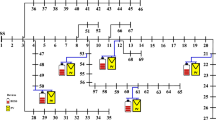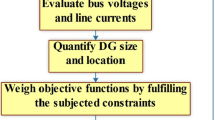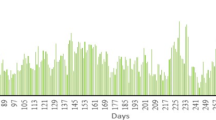Abstract
Soft Normally Open Point (SNOP) is a power electronic device used widely in power distribution network. It can solve many problems by adjusting reactive power compensation and active power transmission. The uncertainty and fluctuation of distributed generation (DG) may cause many problems to the distribution network. In order to balance the safety and economy in power flow optimization better, a self-adaptive power flow optimization method for active distribution network with multi-terminal SNOP considering difference of the risk of node voltage beyond limit is put forward. It takes both weighted voltage deviation and the network loss into objective function to construct the optimal operation model and mainly has two improvements: one is considering initial voltage deviation and real-time penetration of the DG to establish the self-adaptive weight model of the sum of voltage deviation in the objective function; the other is putting forward the weighting strategy for node voltage deviation which decided by the electrical distance, DG position and correlation between source output and load. Then, taking three improved IEEE33 node feeders as an example to verify the validity of the strategy. The results validate that the self-adaptive strategy can reduce the loss and improve the regulation of voltage better and is useful in distribution network under different penetration.








Similar content being viewed by others
References
Liu W, Wang S, Chen Y, Chen X, Liu Z (2017) Coordinate optimization of the distribution network electricity price, energy storage operation strategy, and capacity under a shared mechanism. Sustainability 9:1080
Wv Y, Lee C, Liv L, Sh T (2010) Study of reconfiguration for the distribution system with distributed generators. IEEE Trans Power Delivery 25(3):1678–1685
Wang Z, Lin M, Yan L, Bian S (2013) Power flow algorithm for distribution network with photovoltaic system. Trans China Electrotech Soc 28(9):178–185
Cao W, Wu J, Jenkins N, Wang C, Green T (2016) Benefits analysis of Soft Open Points for electrical distribution network operation. Appl Energy 165:36–47
Xiao J, Gang F, Jiang X, Huang R, Wei T, Zhang W (2017) Flexible distribution network: definition, morphology and operation mode. Power Syst Technol 41(5):1435–1442
Cao W, Wu J, Jenkins N, Wang C, Green T (2016) Benefits analysis of soft open points for electrical distribution network operation. Appl Energy 165:36–47
Aithal A, Long C, Cao W et al (2016) Impact of soft open point on feeder automation. In: 2016 IEEE international energy conference (ENERGYCON), Leuven, Belgium, 4–8 April 2016. IEEE, pp 1–6
Cao W, Wu J, Jenkins N, Wang C, Green T (2016) Operating principle of soft open points for electrical distribution network operation. Appl Energy 164:245–257
Huang R, Cheng L, Li H (2016) Research on the key technology of AC/DC hybrid active distribution network. Distrib Utilization 36(8):1
Cao W (2015) Soft open points for the operation of medium voltage distribution networks. Neuroscience 11(3):627–644
Cao W, Wu J, Jenkins N, Wang C, Green T (2016) Operating principle of soft open points for electrical distribution network operation. Appl Energy 164:245–257
Bloemink JM, Green TC (2013) Benefits of distribution-level power electronics for supporting distributed generation growth. IEEE Trans Power Delivery 28(2):911–919
Bloemink JM, Green TC (2010) Increasing distributed generation penetration using soft normally-open points. In: IEEE PES general meeting, Providence, RI, USA, 25–29 July 2010. IEEE, pp 1–8
Bloemink JM, Green TC (2011) Increasing photovoltaic penetration with local energy storage and soft normally-open points. In: 2011 IEEE power and energy society general meeting, San Diego, CA, USA, 24–29 July 2011. IEEE, pp 1–8
Cao W, Wu J, Jenkins N (2014) Feeder load balancing in MV distribution networks using soft normally-open points. In: IEEE PES innovative smart grid technologies, Europe, Istanbul, Turkey, 12–15 October 2014. IEEE, pp 1–6
Qi Q, Wu J, Zhang L, Cheng M (2016) Multi-objective optimization of electrical distribution network operation considering reconfiguration and soft open points. Energy Procedia 103:141–146
Li P, Ji H, Wang C, Zhao J, Song G, Ding F, Wu J (2017) A coordinated control method of voltage and reactive power for active distribution networks based on soft open point. IEEE Trans Sustain Energy 99:1
Zhang L, Tang W, Bai M, Cong P (2015) Analysis of distribution generation influences on the voltage limit violation probability of distribution line. Energy Power Eng 05(4):756–762
Zhang L, Harnefors L, Nee HP (2011) Modeling and control of VSC-HVDC links connected to island systems. IEEE Trans Power Syst 26(2):783–793
Wang C, Xiong R, He H, Ding X, Shen W (2016) Efficiency analysis of a bidirectional DC/DC converter in a hybrid energy storage system for plug-in hybrid electric vehicles. Appl Energy 183:612–622
Daelemans G, Srivastava K, Reza M et al (2009) Minimization of steady-state losses in meshed networks using VSC HVDC. In: 2009 IEEE power & energy society general meeting, Calgary, AB, Canada, 26–30 July 2009. IEEE, pp 1–5
Momoh JA, Zhu JZ (1999) Improved interior point method for OPF problems. IEEE Trans Power Syst 14(3):1114–1120
Nick M, Cherkaoui R, Paolone M (2014) Optimal allocation of dispersed energy storage systems in active distribution networks for energy balance and grid support. IEEE Trans Power Syst 29(5):2300–2310
Wang C, Song G, Li P, Ji H, Zhao J, Wu J (2016) Optimal configuration of soft open point for active distribution network based on mixed-integer second-order cone programming. Energy Procedia 103:70–75
GBl2325-2008 Power quality—deviation of supply voltage[S]
Acknowledgements
This work is supported by National key research and development program of China (2017YFB0903100) and Science and Technology Projects of State Grid Corporation of China (521104170043).
Author information
Authors and Affiliations
Corresponding author
Additional information
Publisher's Note
Springer Nature remains neutral with regard to jurisdictional claims in published maps and institutional affiliations.
Rights and permissions
About this article
Cite this article
Xu, Y., Wang, Z., Fang, Z. et al. Self-adaptive Power Flow Optimization Method for Multi-terminal SNOP Considering the Difference of Risk of Node Voltage beyond Limit. J. Electr. Eng. Technol. 14, 1963–1971 (2019). https://doi.org/10.1007/s42835-019-00249-z
Received:
Revised:
Accepted:
Published:
Issue Date:
DOI: https://doi.org/10.1007/s42835-019-00249-z




